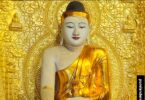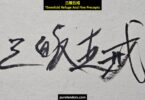 External Aids’ Positions [1]
External Aids’ Positions [1] External Aids’ Positions [2]
External Aids’ Positions [2] Support-Chanting Layout For The Dying [1]
Support-Chanting Layout For The Dying [1]
 Support-Chanting Layout For The Dying [2]
Support-Chanting Layout For The Dying [2] Support-Chanting Layout For Wakes
Support-Chanting Layout For Wakes Buddha’s Shrine
Buddha’s Shrine Deceased’s Shrine
Deceased’s Shrine
Notes:
[1] For more attention of the dying person’s consciousness, guider should move closer to the bed when offering guidance, before moving back to be one of the support-chanters. Likewise, for more attention of the deceased’s consciousness, who might be near the casket, guider should move closer when offering guidance, before moving back to be one of the support-chanters.
[2] For more attention of everyone at the wake, leader should move to the centre when coordinating bowing (and chanting) with guiding bell (引擎), before moving back to be one of the support-chanters. (See second related article below for details of what to be chanted.) The ‘Support-Chanting Layout For Wakes’ above is based upon the most common wake structures in Singapore, with the context of tentage surrounding three sides of the casket. As the area within might be stuffy, there is only one row of support-chanters flanking left and right in the tentage, next to the casket, with the rest outside. If there are larger or no tentages, such as at spacious funeral parlours, more can sit on sides.
[3] (a) Black circle represents head area. (b) Arrows point to where those seated or standing should face. (c) Āmítuófó image can be a hung picture or a statue on a small table.
Usually, it is not considered appropriate Buddhist etiquette to have one’s feet (which represents the most lowly and dirty part of our bodies) point at Buddha images. However, for bedridden dying patients, it is an exception – if having the Buddha image central in front, in the direct line of sight is the best and natural position to see it, for a clear sense of refuge and focus. If the patient is not comfortable with this, it can be slightly to the side. (When the Buddha comes, he will be at most natural line of sight too, and will not be bothered by feet pointing at him, while such a dying person will not have disrespect then.)
As some at the wake might be unhappy with the deceased’s feet pointing at a Buddha image at the casket area, it is placed at the head area instead. To summarise on the Buddha image’s position in relation to the dying and deceased, it is ‘front for the dying, and back for the deceased’ (生前往后).
[4] Mantra wheels (咒轮) are paper versions. They are not prayer wheels (经轮), which can still be touched or turned for blessings, but not placed on the body as might be heavy. Those not too sick or weak might wish to hold and turn one. However, to reach Pure Land, there should be more focus on sincere mindfulness of Āmítuófó’s name directly.
[5] Optional Buddha’s shrine in the room of the dying can be makeshift, using a picture or statue, with periodical simple offerings of water, light and fruits. (Avoid incense and oil lamps if smoky and depletes much air.) If patient is able to express reverence, there can be half or full prostration at the shrine, or joining palms towards it. If offerings are made on behalf of the patient, there should be informing for rejoice. Only Maha-Vegan food and drink should be offered to the Buddha and patient – i.e. without meat, animal products, five pungent roots and alcohol. (Illustrative photos below are used with permission of family of the departed. Although layouts and contents of offerings at the wake vary slightly, their significance is the same as above.)
[6] During support-chanting for the dying, there can be 3 rotating shifts, with each shift of 1 hour each, with at least 2 support-chanters (including guider), for moral support and higher volume, and in case there is need for one to leave. Those in the active shift should be in the room, with others taking breaks or chanting outside, aloud or silently.
 Overall Pure Land Buddhist Wake Setup
Overall Pure Land Buddhist Wake Setup Outer Position Of Support-Chanters
Outer Position Of Support-Chanters
 Inner Position Of Support-Chanters
Inner Position Of Support-Chanters Buddha’s Shrine
Buddha’s Shrine Deceased’s Shrine
Deceased’s Shrine
 Alternative (Home Or Wake) Tablet For The Deceased
Alternative (Home Or Wake) Tablet For The Deceased
Related Articles:
阿弥陀佛像在丧礼的摆设
Amitābha Buddha’s Image’s Placement At Wakes
https://purelanders.com/2022/01/buddha-image-placement-at-wakes
Other Considerations Before, During & After Dying
https://purelanders.com/now
What Should Be Chanted During & After A Funeral
https://purelanders.com/wake
佛教丧礼所严禁之通告
Notice On Buddhist Wake’s Strict Prohibitions
https://purelanders.com/2019/01/30/notice-on-buddhist-wakes-strict-prohibitions
十大陀罗尼被(往生被)须知
[20] Top Ten Facts To Know About The Dhāraṇī (Rebirth) Blanket
https://purelanders.com/2023/02/25/top-ten-facts-to-know-about-the-dhara%e1%b9%87i-rebirth-blanket





